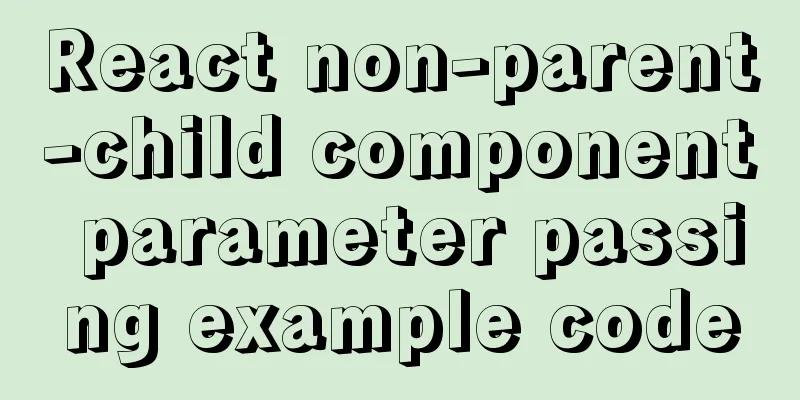React non-parent-child component parameter passing example code

|
React is a JAVASCRIPT library for building user interfaces. React is mainly used to build UI, and many people think that React is the V (view) in MVC. React originated as an internal project at Facebook, used to build Instagram's website, and was open sourced in May 2013. React has high performance and very simple code logic, and more and more people have begun to pay attention to and use it. React Features1. Declarative design − React uses a declarative paradigm that makes it easy to describe applications. 2. Efficiency − React minimizes the interaction with DOM by simulating DOM. 3. Flexible − React works well with known libraries or frameworks. 4.JSX − JSX is an extension of JavaScript syntax. Using JSX is not required for React development, but it is recommended. 5. Components − Building components with React makes the code easier to reuse and can be well applied in the development of large projects. 6. One-way responsive data flow − React implements one-way responsive data flow, which reduces duplication of code, which is why it is simpler than traditional data binding. Here is an example code for React non-parent-child component parameter passing. The specific content is as follows: New version: The main purpose of cross-level parameter passing is to avoid assigning values at each level and also avoid using dva
import React from 'react'
const {Provider, Consumer} = React.createContext('default')
export default class ContextDemo extends React.Component {
state={
newContext:'createContext'
}
render() {
const { newContext } = this.state
return (
<Provider value={newContext}>
<div>
<label>childContent</label>
<input type="text" value={newContext} onChange={e=>this.setState({newContext:e.target.value})}/>
</div>
<Son />
</Provider>
)
}
}
class Son extends React.Component{
render(){
return <Consumer>
{
(name)=>
<div style={{border:'1px solid red',width:'60%',margin:'20px auto',textAlign:'center'}}>
<p>Content obtained by the subcomponent: {name}</p>
<Grandson />
</div>
}
</Consumer>
}
}
class Grandson extends React.Component{
render(){
return <Consumer>
{
(name)=>
<div style={{border:'1px solid red',width:'60%',margin:'20px auto',textAlign:'center'}}>
<p>The content obtained by the grandchild component: {name}</p>
</div>
}
</Consumer>
}
}The old project method is also introduced, using prop-types
import React from 'react'
import PropTypes from 'prop-types'
class ContextDemo extends React.Component {
// getChildContext
state={
newContext:'createContext'
}
getChildContext(){
return {value:this.state.newContext}
}
render() {
const { newContext } = this.state
return (
<div>
<div>
<label>childContent</label>
<input type="text" value={newContext} onChange={e=>this.setState({newContext:e.target.value})}/>
</div>
<Son />
</div>
)
}
}
class Son extends React.Component{
render(){
return <div>
<p>children:{this.context.value}</p>
</div>
}
}
Son.contextTypes = {
value:PropTypes.string
}
ContextDemo.childContextTypes = {
value:PropTypes.string
}
export default () =>
<ContextDemo>
</ContextDemo>ref
import React from 'react'
// Function components also want to get dom through ref
const TargetFunction = React.forwardRef((props, ref) => (
<input type="text" ref={ref}/>
))
export default class FrodWordRefDemo extends React.Component {
constructor() {
super()
this.ref = React.createRef()
}
componentDidMount() {
this.ref.current.value = 'ref get input'
}
render() {
return <TargetFunction ref={this.ref}>
</TargetFunction>
}
}pubsub-js
import React from 'react'
import PubSub from 'pubsub-js'
export default class Bro extends React.Component{
state = {
value:''
}
render(){
const {value} = this.state
PubSub.subscribe('SOS',(res,data)=>{
this.setState({
value:data
})
})
return (
<div>
I received <h1>{value}</h1>
</div>
)
}
}
import React from 'react'
import PubSub from 'pubsub-js'
export default class Children extends React.Component{
state = {
value:''
}
handelChange = (e) => {
this.setState({
value:e.target.value
})
}
send = () => {
const {value} = this.state
PubSub.publish('SOS',value)
}
render(){
const {value} = this.state
return (
<div>
<input type="text" value={value} onChange={this.handelChange}/>
<button onClick={this.send}>Send</button>
</div>
)
}
}This is the end of this article about the example code of React non-parent-child component parameter passing. For more relevant React non-parent-child component parameter passing content, please search 123WORDPRESS.COM's previous articles or continue to browse the following related articles. I hope everyone will support 123WORDPRESS.COM in the future! You may also be interested in:
|
<<: Network configuration of Host Only+NAT mode under VirtualBox
>>: Installing Win10 system on VMware workstation 14 pro
Recommend
Detailed explanation of the difference between MySQL normal index and unique index
Table of contents 1 Conceptual distinction 2 Case...
Definition and usage of MySQL cursor
Creating a Cursor First, create a data table in M...
Use CSS3 background control properties + color transition to achieve gradient effect
css3 background image related Compatibility: IE9+...
W3C Tutorial (16): Other W3C Activities
This section provides an overview of some other i...
Various ways to modify the background image color using CSS3
CSS3 can change the color of pictures. From now o...
Vue's vue.$set() method source code case detailed explanation
In the process of using Vue to develop projects, ...
Vue3 Documentation Quick Start
Table of contents 1. Setup 1. The first parameter...
Install MySQL (including utf8) using Docker on Windows/Mac
Table of contents 1. Docker installation on Mac 2...
Using CSS3 to create header animation effects
Netease Kanyouxi official website (http://kanyoux...
Detailed explanation of how to use structural pseudo-class selectors and pseudo-element selectors in CSS3
Introduction to structural pseudo-class selectors...
Solve the problem of installing Theano on Ubuntu 19
Solution: Directly in the directory where you dow...
Common JavaScript memory errors and solutions
Table of contents 1. Timer monitoring 2. Event mo...
Code analysis of synchronous and asynchronous setState issues in React
React originated as an internal project at Facebo...
Detailed tutorial on VMware installation of Linux CentOS 7.7 system
How to install Linux CentOS 7.7 system in Vmware,...
Solution to forgetting the password of the pagoda panel in Linux 3.X/4.x/5.x
Enter ssh and enter the following command to rese...









